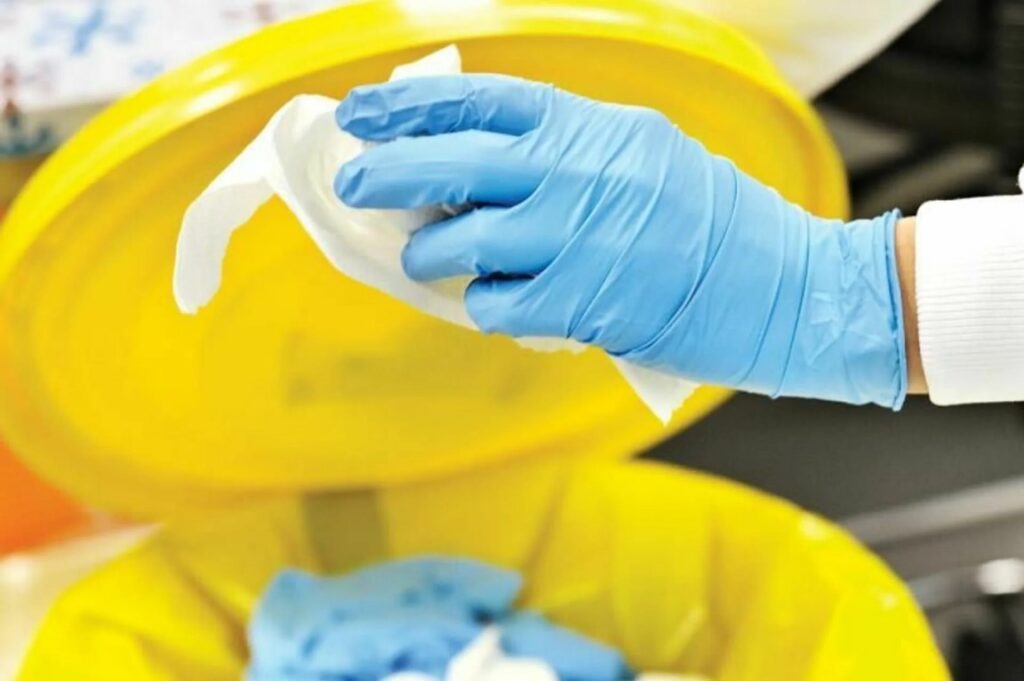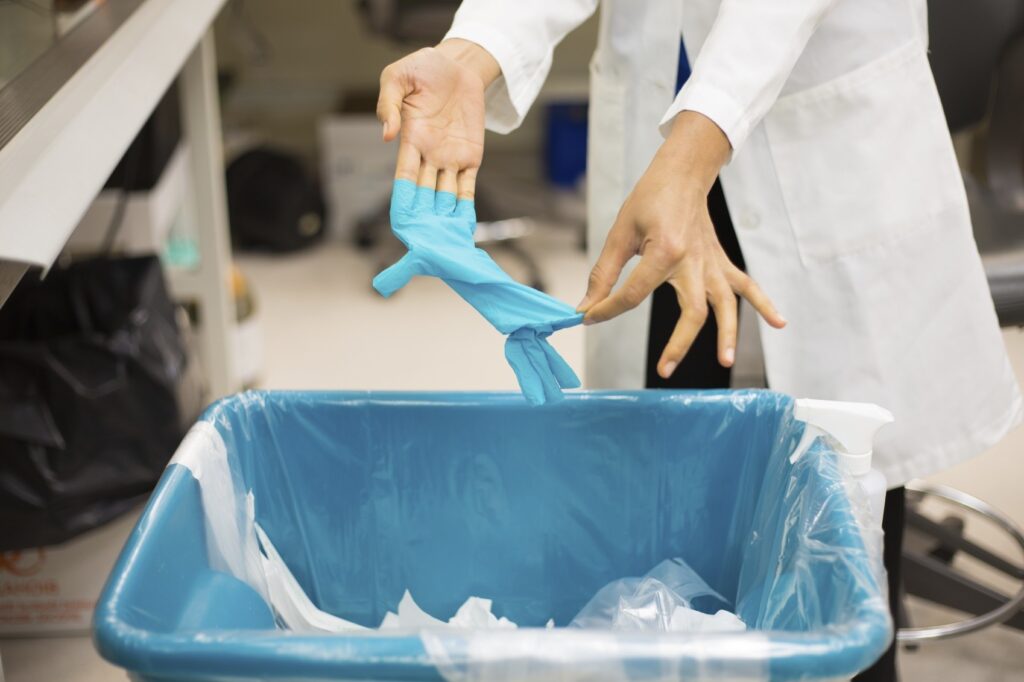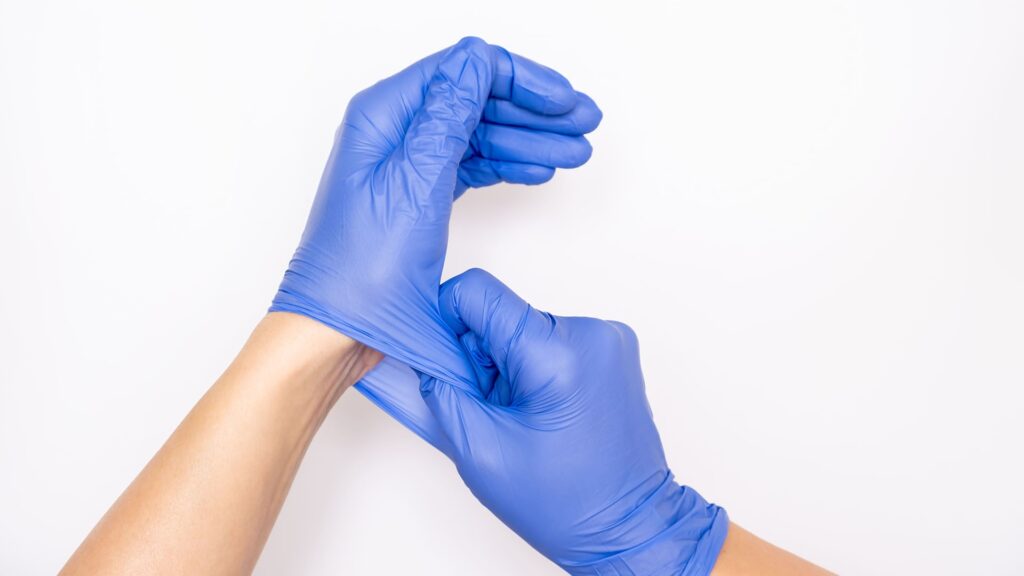
In our daily lives, we often overlook the importance of proper gloves disposal. Whether we use gloves for medical purposes, in laboratories, or even for household chores, it is crucial to dispose of them correctly. Glove disposal involves removing gloves from your hands in ways that reduce hazardous or infectious waste.
In this blog post, we will delve into the environmental impact of improper glove disposal, the prevalence of glove waste, and its harmful effects on the environment. We will also explore the role of improper glove disposal in contributing to climate change and provide case studies highlighting the environmental consequences. Finally, we will emphasize the importance of proper glove recycling and disposal methods.
Improper gloves disposal has severe environmental consequences
The accumulation of glove waste in landfills and water sources contributes to pollution and poses a threat to wildlife and ecosystems. Gloves are a crucial part of many industries, including healthcare and laboratory work. However, their disposal process is often overlooked. It is important to handle gloves properly to avoid contact with germs and other harmful substances.
In addition to proper glove disposal, it’s important to note that we should also stop using gloves when they are no longer necessary. Gloves are not a substitute for good hygiene practices and should only be used when handling potentially harmful substances or when in contact with people who are ill. It’s also important to note that when removing gloves, you should peel off the second glove from the inside to avoid contamination. Affordable and durable gloves are available in the market, which can be used for various purposes. It’s crucial to follow the guideline for glove disposal and handling to ensure the safety of oneself and others.
Needle and syringe disposal
Needle and syringe disposal is also a crucial part of healthcare and laboratory work. Sharps should be placed in puncture-proof containers and disposed of according to local guidelines. Face shields are another important tool that can be used to prevent the spread of germs. They should be cleaned regularly and disposed of if they become damaged or contaminated.
A brief explanation of the importance of proper glove disposal
Gloves are a crucial component of personal protective equipment (PPE) that is used in various industries, including healthcare, food service, and manufacturing. They provide a barrier between the user and the environment, protecting against harmful substances and bacteria.
Proper glove disposal is essential for protecting the environment and our health. By recognizing the environmental consequences of improper glove disposal, adopting sustainable waste management practices, and promoting education and awareness, we can minimize the negative impact of glove waste on our planet.
In today’s world, proper glove disposal has become an increasingly important issue. The use of gloves has become prevalent in various industries, ranging from healthcare to food service, and even in everyday life. However, the improper disposal of gloves has severe consequences for the environment.

The prevalence of glove waste
1. Statistics reveal a significant increase in the use of gloves across various industries
With the rise in healthcare services, the demand for gloves has surged, leading to a surge in waste generation.
2. Lack of awareness regarding proper disposal methods
Unfortunately, many individuals are not aware of the proper methods for disposing of gloves. People often dispose of them along with regular trash, resulting in unnecessary environmental harm.
The harmful effects of glove waste on the environment
1. Chemical contamination from non-biodegradable materials in gloves
Gloves made of non-biodegradable materials, such as nitrile and latex, introduce chemicals into the environment when improperly disposed of. These chemicals can contaminate soil and water, posing a threat to human health and ecosystems.
2. Pollution of landfills and water sources
The accumulation of glove waste in landfills contributes to pollution. As gloves break down slowly or not at all, they take up valuable space and release harmful substances into the surrounding environment.
3. Negative impact on wildlife and ecosystems
Wildlife and ecosystems also suffer from the negative impacts of glove waste. Animals can mistake gloves for food, leading to choking, entanglement, and even death. The contamination of water sources affects aquatic life and disrupts delicate ecosystems.
The role of improper glove disposal in contributing to climate change
1. The production and disposal of gloves contribute to greenhouse gas emissions
From the manufacturing process to the transportation of gloves and their eventual disposal, fossil fuels are consumed, further exacerbating climate change.
2. The link between glove waste and fossil fuel consumption
Improper glove disposal increases the demand for disposable gloves, which are often made from fossil fuel-derived materials. This perpetuates the cycle of fossil fuel consumption and environmental degradation.

Case studies on the environmental consequences of improper glove disposal
1. Numerous examples demonstrate the devastating environmental consequences of glove waste
Polluted water sources, contaminated with glove debris, endanger both human health and aquatic life.
2. Instances of wildlife suffering from glove-related pollution
Instances of animals entangled in gloves or mistaking them for food highlight the urgent need for proper glove disposal.
The importance of proper glove recycling and disposal methods
To mitigate the environmental impact of glove waste, it is crucial to adopt proper recycling and disposal methods. Here are a few steps that can be taken:
1. Collection and Recycling
Implement collection programs specifically for glove waste, making it easier for individuals and businesses to recycle their used gloves. Many gloves can be recycled, especially nitrile gloves, which can be processed and transformed into new products.
2. Proper Disposal
If recycling is not available, gloves should be disposed of as hazardous waste, following local guidelines and regulations. This ensures that they are handled and treated appropriately, minimizing their impact on the environment.
3. Education and Awareness
Promote education and awareness campaigns to inform individuals and industries about the importance of proper glove disposal. By raising awareness, we can encourage responsible waste management practices and reduce the environmental impact of glove waste.
A step-by-step guide to correct glove disposal
It is crucial to follow proper glove disposal methods to mitigate environmental harm. Recycling gloves can help reduce waste and conserve valuable resources.
- Pinch the outside of the glove at the wrist.
- Peel the glove away from the hand, pulling it inside out.
- Hold the glove in the opposite gloved hand.
- Slide an ungloved finger under the wrist of the remaining glove.
- Peel the glove away from the inside, creating a bag for both gloves.
- Dispose of the gloves in the appropriate waste bin.

Innovations in Sustainable Glove Materials and Production
Innovations in sustainable glove materials and production can help reduce the negative impact of glove waste on the environment. Biodegradable and eco-friendly glove alternatives are being introduced to the market, which can help reduce the amount of waste generated from glove production and disposal.
Innovations in sustainable glove materials and production and collaboration between manufacturers, consumers, and waste management organizations can help reduce the amount of glove waste generated and promote sustainability.
How to Safely Dispose of Gloves?
- First, remove your gloves properly. To do this, pinch the outside of one glove at the wrist and peel it away from your hand, being careful not to touch the contaminated surface. Hold the removed glove in your other gloved hand. Then, pinch the outside of the second glove at the wrist and peel it away from your hand, turning the glove inside out as you remove it. Hold the removed gloves in your other gloved hand, with the first glove inside the second glove.
- Dispose of the gloves in a proper waste disposal bin. If the gloves are contaminated with bodily fluids or other biohazardous waste, they should be disposed of in a biohazardous waste bin. If the gloves are not contaminated, they can be disposed of in a regular trash bin.
- If you’re disposing of disposable gloves, they should be thrown away after each use. Do not reuse disposable gloves, as they can become contaminated and spread harmful substances.
- If you are wearing reusable gloves, such as latex or vinyl gloves, they should be washed and disinfected after each use. Check the manufacturer’s guidelines for specific instructions on how to clean and disinfect your gloves.
Companies leading the way in environmentally conscious glove manufacturing
Companies are also leading the way in environmentally conscious glove manufacturing, reducing the amount of energy and resources required for production. Some examples of sustainable glove materials include:
- Bamboo gloves: Made from renewable bamboo fibers.
- Recycled nitrile gloves: Made from 100% recycled nitrile gloves.
- Compostable gloves: Made from compostable materials that can break down in a compost pile.

The role of individuals and organizations in promoting responsible glove disposal
Individuals and organizations can play a crucial role in promoting responsible glove disposal. Education and awareness among healthcare professionals and industry workers can help reduce the amount of glove waste generated. Collaboration between manufacturers, consumers, and waste management organizations can help develop effective recycling and disposal programs. Organizations can also promote glove recycling programs and initiatives to encourage sustainable practices.
In conclusion, proper glove disposal is important to reduce the negative impact of glove waste on the environment. By following proper glove recycling and disposal methods, individuals and organizations can help promote environmentally conscious practices and contribute to the fight against climate change. Innovations in sustainable glove materials and production and collaboration between manufacturers, consumers, and waste management organizations can help reduce the amount of glove waste generated and promote sustainability.
Warnings
- When removing gloves, peel them away from your body to avoid touching the contaminated surface. Remove them properly and dispose of them in the garbage.
- Gloves cannot be recycled and should not be flushed down the toilet. They should be disposed of in the garbage and not left lying around.
- If you’re working in a lab or medical facility, there may be specific guidelines and disposal services you should follow.
- It is important to ensure that gloves are not mixed with general waste to avoid contaminating other materials. In addition, gloves should be removed properly to avoid contact with bodily fluids or other contaminants.
- When disposing of gloves, they should be placed in designated recycling bins or containers. This ensures that they are handled and processed correctly, minimizing their impact on the environment.
- Improper glove disposal can have serious consequences. If contaminated gloves are not disposed of properly, they can contaminate other surfaces and objects, spreading harmful substances and increasing the risk of infection.
- In addition, improperly disposed gloves can harm the environment by polluting water and soil.
- It is safe to assume that any pair of gloves used to touch a potentially contaminated surface is contaminated. If you notice a hole or a tear, remove your gloves immediately, wash your hands, and switch to a new pair.
- After a few hours of wear, disposable gloves start to lose their strength, and their protective barrier starts to degrade. This means you won’t be protected against injuries, chemicals, and viruses.
Tips
- There are different glove types available, each with its own durability and cuff length. It is important to choose a glove that is appropriate for the task at hand.
- It’s also crucial to wash your hands after handling gloves or any object that may have come into contact with people or harmful substances.
- Face shields and syringes are also important tools that can exponentially reduce the risk of infection.
- Proper glove recycling and disposal methods can help reduce the negative impact of glove waste on the environment.
- To properly dispose of gloves, they should be thrown in the appropriate waste bin, such as a biohazardous waste bin or a recycling bin for gloves that can be recycled.
- Help reduce waste and promote recycling when you switch out your latex gloves for nitrile gloves!
- If you don’t have access to biohazard waste plastic bags, you may use a regular plastic bag instead.
- When collecting your used uncontaminated nitrile gloves make sure that they are placed inside a latex-free clear plastic liner.
- If you’ve worn your disposable nitrile gloves once, they’ve unfortunately reached the end of their lifespan and you should never try to breathe new life into them.
Conclusion
In conclusion, proper glove disposal is vital for protecting the environment and preventing climate change. Unfortunately, finding gloves and masks thrown on the ground in the street is not yet a rare occurrence: uncivilized behavior (especially if you consider that such devices could be dangerous). You might not have thought about it, but if you throw your gloves without ensuring you’ve done so safely, these gloves could end up in the environment and even the oceans, where they produce pollution and can be harmful to wildlife.
By raising awareness, promoting recycling, and following correct disposal methods, we can minimize the harmful effects of glove waste and foster a more sustainable future. Let’s take responsibility for our glove waste and ensure a cleaner and healthier planet.
Overall, proper glove disposal and handling should be an important consideration in any industry where gloves are used. By following the guidelines for disposal, we can ensure the safety of ourselves and others while minimizing harm to the environment. With affordable and durable glove options available, there’s no excuse for not taking proper precautions. So, let’s all do our part and dispose of gloves, syringes, and other potentially harmful materials responsibly and safely.

